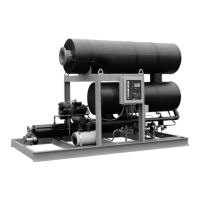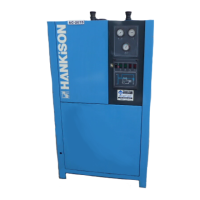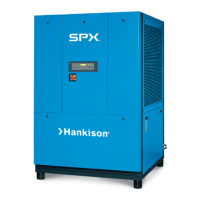4
E
N
G
L
I
S
H
B. Holes are provided in the dryer base to permanently
mount it to a level solid floor. Ensure the dryer is level
by grouting, if necessary. The structural steel base is of
an open design to facilitate cleaning and washing
under the unit.
2.4 Piping
Utility connections should be made
without equipment forces or moments at any connec-
tion point.
A. Air Inlet & Outlet
1. Connect compressed air lines to connections
marked “Air Inlet” and “Air Outlet” on dryer. Inlet
and outlet should be connected to air lines of
equal or larger diameter than piping sizes fur-
nished on the dryer. Check drawing for Inlet and
Outlet location and size.
2. Use of a 1/16" thick flat ring compressed synthetic
gasket (Garlock or equal) is recommended. At the
time of installation, the gaskets should be coated
with a high grade lubricant to facilitate making a
tight joint. Crane thread lubricant (or equal) is
recommended.
A pressure relief valve must be
installed to protect the dryer pressure vessels from
over pressurization. No valves may be located
between the dryer and the pressure relief device.
Check local codes for other requirements.
B. Automatic Condensate Drains
Automatic condensate drains are piped to a common
fitting on the base plate. Condensate should be
piped from this fitting to an open, vented floor drain
or sump.
Liquid discharge is at system pressure
and may require that drain line be anchored.
Do not put a valve in the drain line or
obstruct the discharge of the condensate in any way
(such as with severe bending of drain line).
C. Water-Cooled Models - Water Supply and Drain Lines
Connect cooling water inlet and outlet. Unit is
supplied with water strainer and water regulating
valve. See Technical Data Section for cooling water
requirements.
NOTE: It is preferable to install inlet and outlet water
pressure and temperature gauges in water system.
2.5 Electrical
If a disconnect switch is utilized, only time
delay, dual-element fuses (Fusetron, or equal) should be
used.
The dryer is designed to run continuously
and must not be wired to cycle on and off with the air
compressor. Dryer compressor can be placed in Standby
Mode during shutdown periods.
2.0 Installation
2.1 Location
A. A moderately heated, well ventilated area is the best
location for the installation of the dryer.
B. Ambient Temperatures:
Water-Cooled - Standard: 35 to 130°F, 2 to 54°C
Optional: -20 to 130°F, -29 to 54°C
Air-Cooled with integral condenser -
Standard: 35 to 110°F, 2 to 43°C
Optional: -20 to 110°F, -29 to 43°C
Air-Cooled with remote mounted condenser -
Dryer only - Standard: 35 to 110°F, 2 to 43°C
Optional: -20 to 110°F, -29 to 43°C
Condenser - Standard: -20 to 110°F, -29 to 43°C
C. Avoid locations immediately adjacent to cold exterior
windows or walls or adjacent to high temperature
ovens or boilers.
D. Dryers should be installed in a location which will
allow ease of servicing, cleaning and good visibility of
furnished instrumentation. A three (3) foot wide
access area should be provided on all sides of dryer.
AIR-COOLED MODELS
A . Air-cooled condensers are furnished
with legs which provide free air movement. DO NOT
obstruct the entering or exiting air across the con-
denser. The outlet vertical air discharge should have
no obstruction within a distance equal to ten times
the diameter of any fan.
B. Avoid installing condenser where air being drawn
across the condenser has been run through and
heated by devices such as air-cooled aftercoolers or
compressor intercoolers. In some cases cooler air can
be diverted into the condenser intake by erecting a
baffle between the condenser and other equipment.
It is also possible to duct cooler air from an external
source to the condenser intake. Care must be taken
that the duct work is large enough so as not to restrict
air flow or that a blower is installed in the duct work to
provide required air flow.
2.2 Position in the compressed air system
This type of dryer is normally located downstream of the
compressor receiver tank and before the main plant air
distribution line(s). A three valve bypass should always be
installed to permit the continued use of the plant com-
pressed air system during any dryer maintenance or
servicing operations. No prefilter upstream of the dryer is
required unless an excessive amount of scale and/or oil is
present in the compressed air system.
2.3 Mounting
A. At the permanent dryer location, remove the dryer
from its shipping pads.

